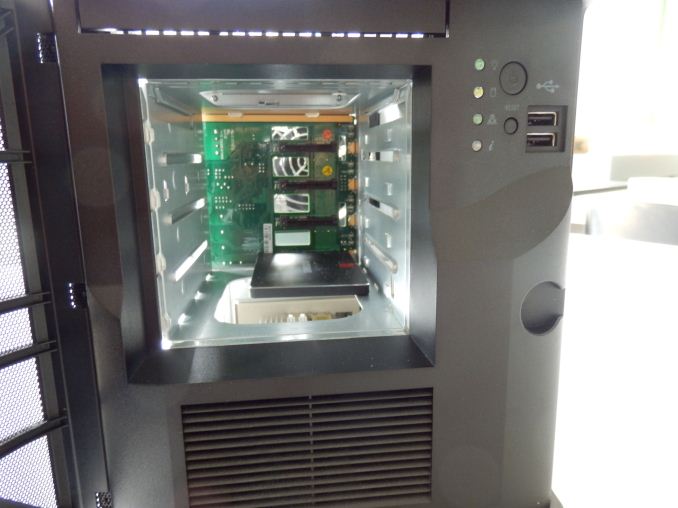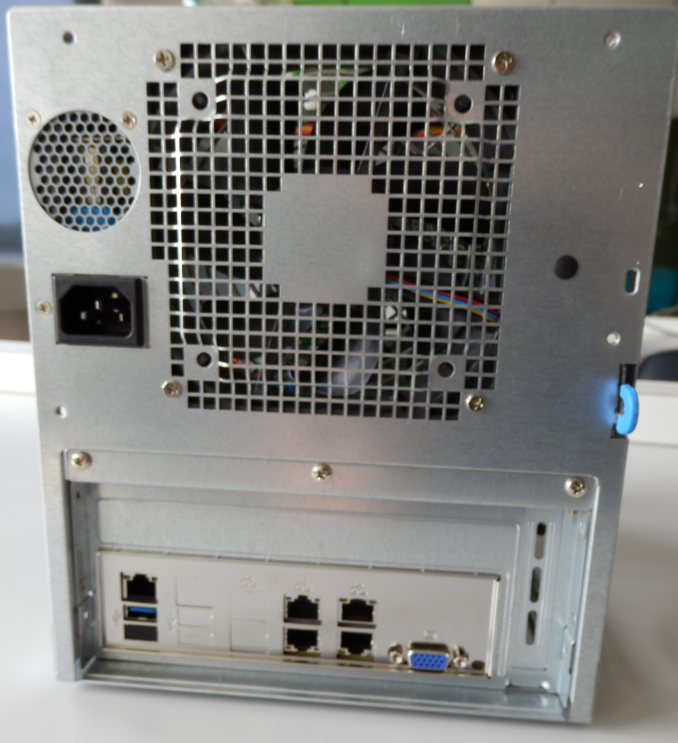The Intel Xeon D Review: Performance Per Watt Server SoC Champion?
by Johan De Gelas on June 23, 2015 8:35 AM EST- Posted in
- CPUs
- Intel
- Xeon-D
- Broadwell-DE
Supermicro's SuperServer 5028D-TN4T
Supermicro has always been one of the first server vendors that integrates new Intel technology. The Supermicro SYS-5028D-TN4T is a mini-tower, clearly targeted at Small Businesses that still want to keep their server close instead of in the cloud, which is still a strategy that makes sense in quite a few situations.
The system features four 3.5 inch hot swappable drive bays, which makes it easy to service the component that fails the most in a server system: the magnetic disks.
That being said, we feel that the system falls a bit short with regards to serviceability. For example replacing DIMMs or adding an SSD (in one of fixed 2.5 inch bays) requires you to remove some screws and to apply quite a bit of force to remove the cover of the chassis.
Tinkering with DIMMs under the storage bays is also a somewhat time consuming experience. You can slide out the motherboard, but that requires to remove almost all cabling. Granted, most system administrators will rarely replace SSDs or DIMMs. But the second most failing component is the PSU, which is not easy swappable either but attached with screws to chassis.
On the positive side, an AST2400 BMC is present and allows you to administer the system remotely via a dedicated Ethernet interface. Supermicro also added an Intel i350 dual gigabit LAN controller. So you have ample networking resources: one remote control ethernet port, two gigabit and two 10 gigabit (10GBase-T) ports, courtesy of the Xeon-D integrated 10 GbE Ethernet MAC.













90 Comments
View All Comments
Kjella - Tuesday, June 23, 2015 - link
Server on a chip? It's not intended for use with a display, it does all it's "supposed to" do for the hyperscale market without any display.close - Tuesday, June 23, 2015 - link
"Intel was able to combine 8 of them together with dual 10 Gbit, 4 USB 3.0 controllers, 6 SATA 3 controller and quite a bit more".This ^^ makes it a SoC. Ok, a video output would be nice but that certainly doesn't disqualify it.
ats - Tuesday, June 23, 2015 - link
cause video isn't required or even wanted in this market segment. It is a SoC, which simply means system on a chip and doesn't have some ironclad definition. Hell, most "SoC" chips aren't really systems on a chip anyways and require significant supporting logic (this is true for just about any cell phone SoC on the market too).bill.rookard - Tuesday, June 23, 2015 - link
Exactly, you would tend to use remote management over the network to admin this type of a unit. I have several rackmounted servers in my basement (I do some home-serving of websites over a business class connection) and while I do have them actually hooked up to a display, I can hardly remember the last time I looked at them as 99.9% of the time I SSH into everything for administration.About the only time you'd ever really use a display is if you were doing multiple VMs of assorted types. Beyond that, it's wattage wasted.
ats - Tuesday, June 23, 2015 - link
Yeah honestly, having several SM boards with their ILM system, the only time I'd ever hook up a display is if the network was down. The SM ILM will fully proxy pretty much anything you want and give you a 1200p display that works for just about anything. And you can remotely hook up CDs, DVDs, BRs, USB, etc through it along with the stand console and keyboard/mouse functions. Its a very nice solution.nightbringer57 - Tuesday, June 23, 2015 - link
Basically, you don't need video output.Even if you do, mainboard manufacturers usually include a third-party chip with dedicated functions that, along other things, provide a VGA port usable for a server use.
In this case, the AST2400 chip offers some basic GPU functions with a VGA port along with many remote control-related stuff.
Adding all those functions to the Intel SoC would be awfully expensive. The chip only requires a simple PCIe x1 connection from the SoC, but provides hundreds of additional pins. Not only would those functions probably be hard to implement on a relatively recent 14nm process, but it would require at least 300 new pins on the SoC to add all the 3rd party chip's functions on it, which is almost impossible to do.
Th-z - Tuesday, June 23, 2015 - link
There doesn't seem to have a concrete definition for the term SoC, but it's ridiculous now with the term SoC bandwagon. Everything seems to be called "SoC" these days as long as a chip has more than one functions integrated. One of examples is people even called current console's integrated CPU and GPU chip as SoC, which doesn't even have networking and other peripheral units in it. When a system has so many "SoCs" inside, the term really has lost its meaning and significance.redzo - Tuesday, June 23, 2015 - link
I'm thinking this is a bad name for a product like this. It reminds of the infamous Celeron D and Pentium D line.nandnandnand - Tuesday, June 23, 2015 - link
Anyone who can figure out Xeon D exists can probably tell the differencewussupi83 - Tuesday, June 23, 2015 - link
I agree with redzo, I think anyone who can figure out a 'Xeon D' exists AND remembers that Pentium & Celeron D's existed would initially assume this is a budget Xeon - which it's clearly not. E4 sounds pretty logical. But sure lets just put D...